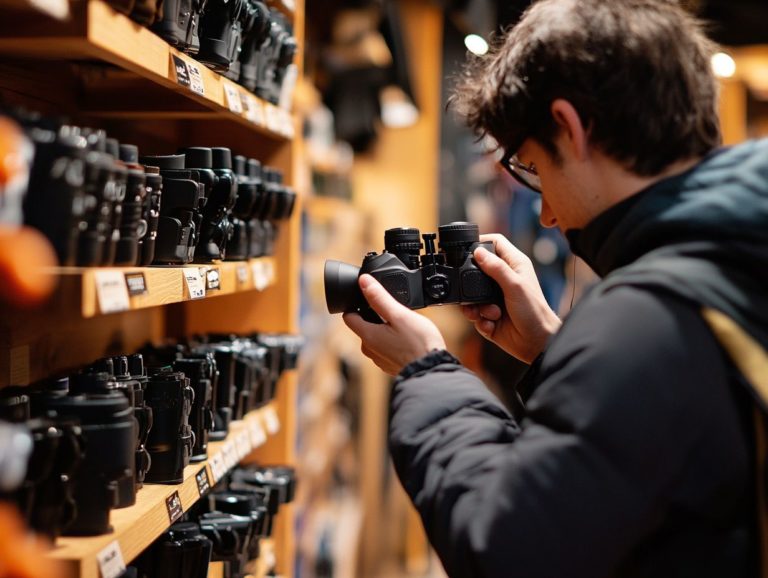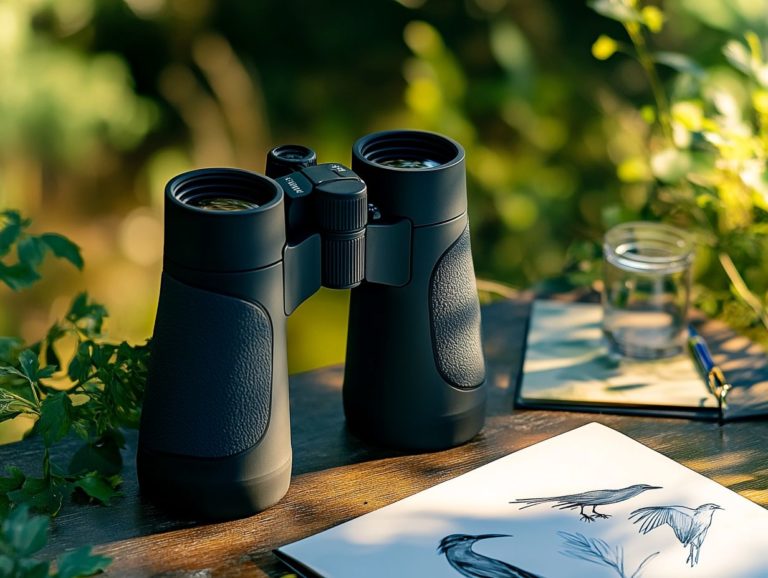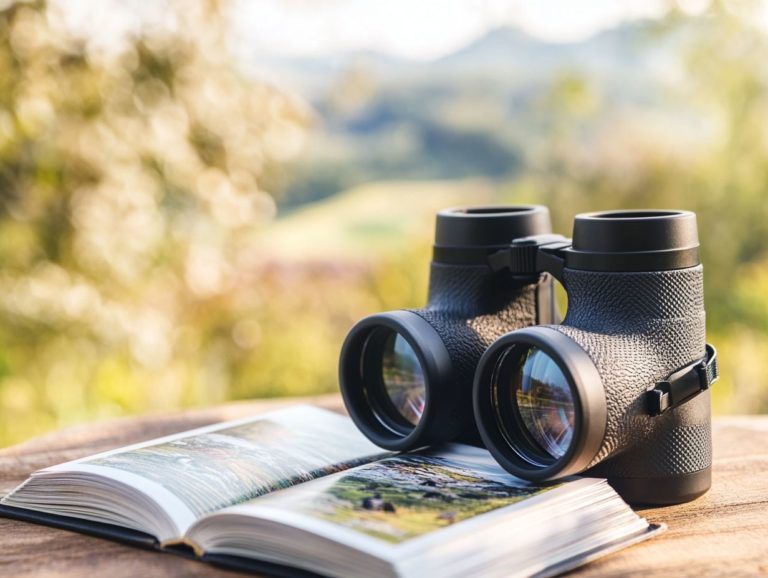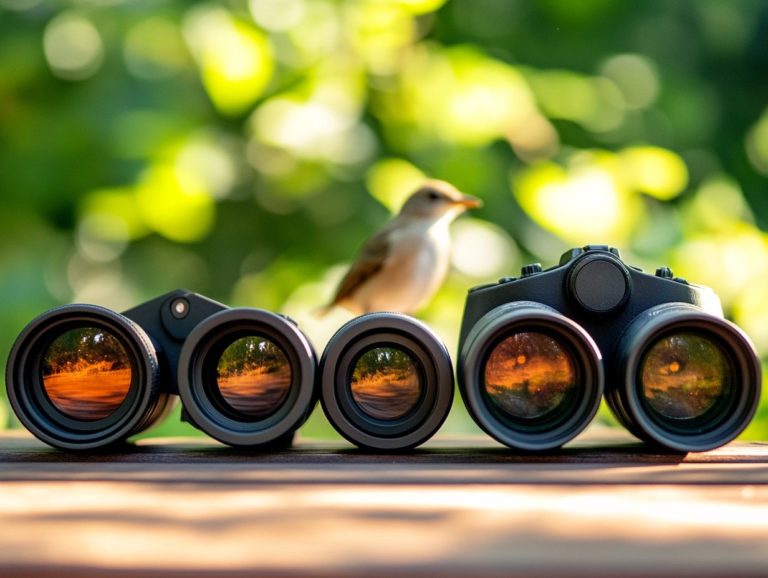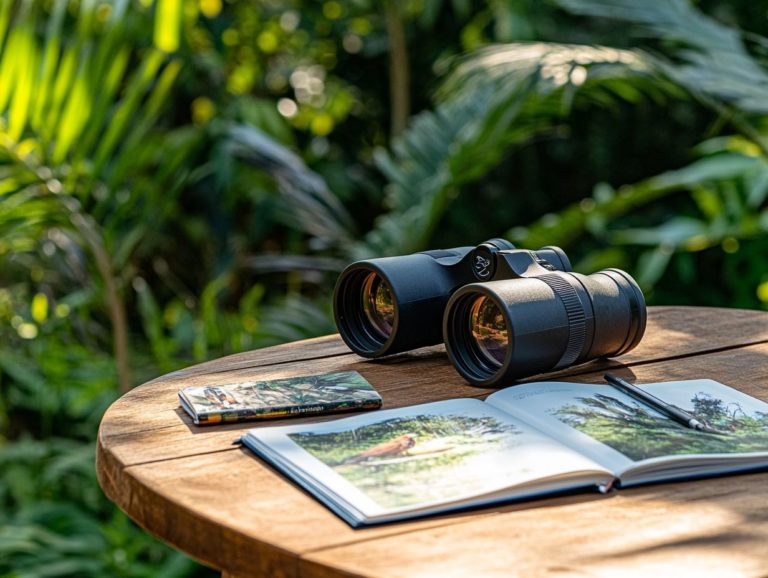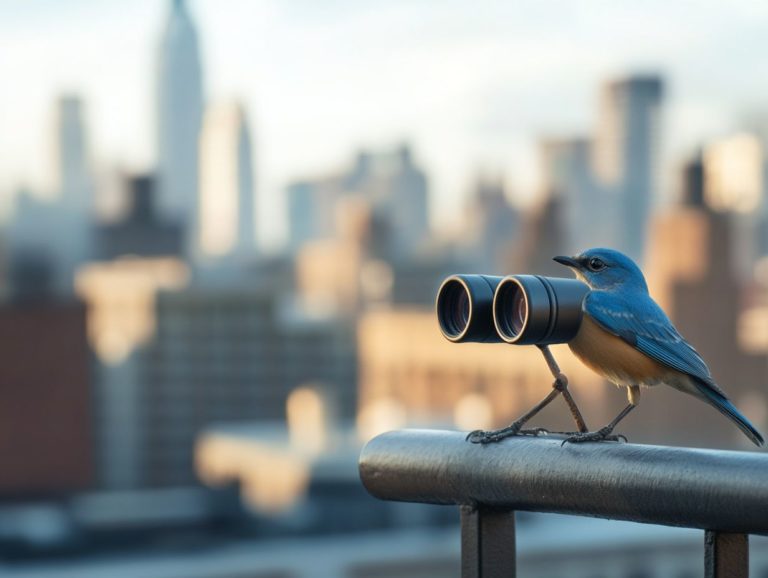Tips for Storing Your Bird Watching Binoculars
Properly storing your binoculars is essential for maintaining their performance, especially if you’re an enthusiastic birdwatcher who relies on these tools for an exceptional experience. Get ready to discover essential cleaning and maintenance tips that will keep your binoculars in top shape for your next adventure!
With straightforward yet effective techniques, you can ensure your binoculars stay in peak condition, ready for your next outing. This guide offers invaluable tips on cleaning and maintenance, advice on choosing the right storage location, recommendations for suitable containers, and strategies for long-term care.
Whether you’re a seasoned birdwatcher or just starting out, these insights will help you safeguard your investment and elevate your viewing pleasure.
Contents
- Key Takeaways:
- Importance of Properly Storing Binoculars
- Preparing Binoculars for Storage
- Choosing the Right Storage Location
- Storage Containers for Binoculars
- Tips for Long-Term Storage
- Retrieving and Using Stored Binoculars
- Frequently Asked Questions
- What are some tips for storing my birdwatching binoculars?
- How should I clean my binoculars before storing them?
- Should I remove the batteries from my binoculars before storing them?
- Is it okay to store my binoculars with the lens caps on?
- Can I hang my binoculars when storing them?
- How often should I clean and maintain my binoculars?
Key Takeaways:
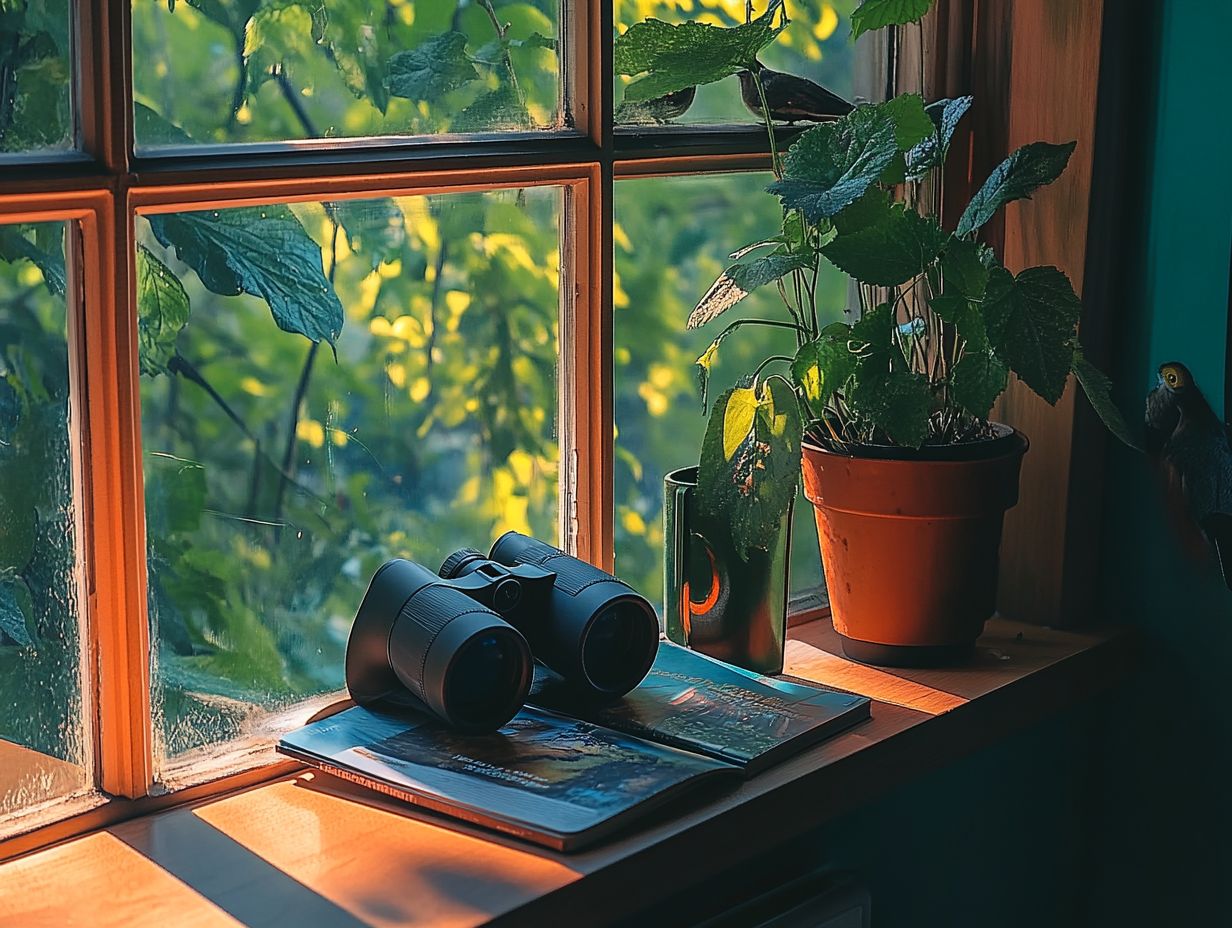
- Proper storage is essential for maintaining the quality and functionality of your birdwatching binoculars. Avoid exposure to extreme temperatures and humidity to prevent damage.
- Before storing your binoculars, clean them and perform necessary maintenance to prolong their lifespan. Use a soft cloth and gentle cleaner to remove dirt and debris.
- Choose a suitable storage location for your binoculars, considering factors such as temperature, humidity, and accessibility. A cool, dry, and secure place is ideal for keeping them in good condition.
Importance of Properly Storing Binoculars
Proper storage of your binoculars is vital for preserving the quality and performance you expect as a birdwatcher or outdoor enthusiast. Neglecting this can lead to damage that affects not only the optical elements but also the stunning images these instruments are designed to deliver.
For dedicated birdwatchers, ensuring that binoculars are stored correctly prolongs their lifespan and enhances performance. Recognizing the significance of proper storage helps you avoid unnecessary wear and tear, making it an essential aspect of your binocular care routine.
Why Proper Storage is Essential for Birdwatching Binoculars
Proper storage of birdwatching binoculars is crucial because it directly impacts their durability and effectiveness in capturing fleeting moments in nature. When stored correctly, they are shielded from dirt and dust that can accumulate over time, which could impair their performance.
Clean your binoculars thoroughly before storing them; this step is simply non-negotiable. By using soft cloths and recommended cleaning solutions, you can maintain both the lenses and the body in pristine condition, preventing scratches or residue buildup.
This gentle maintenance routine not only preserves the clarity of your images but also extends the lifespan of your binoculars, allowing you to enjoy your explorations without interruptions.
Preparing Binoculars for Storage
Preparing your binoculars for storage requires careful cleaning and maintenance that guarantees their longevity and optimal performance for future excursions. Cleaning is crucial; it protects the optical elements from dirt and moisture that could severely compromise visibility and image quality.
Take the time to clean your lenses with suitable cleaning solutions and soft lens cloths. This will help preserve the integrity of the lens coatings and prevent scratches. By adhering to these tips and using lens covers, you can keep your binoculars in prime condition, ready for your next birdwatching adventure.
Cleaning and Maintenance Tips
When it comes to cleaning and maintaining your binoculars, adopting a gentle yet effective approach is essential to protect delicate optical elements. Handling them with care is crucial; even the smallest mishap can lead to misalignment or scratches that could compromise their performance.
A fundamental practice is to always use lens covers when your binoculars are not in use. This simple step serves as a barrier against dust, moisture, and debris that can cloud your view. Regular inspections are also key; they help you spot early signs of wear or damage that may require professional servicing.
Knowing when to seek expert help ensures that the intricate mechanics and optics receive the thorough attention they deserve, guaranteeing long-lasting clarity and efficiency.
Implement these tips on your binocular storage right away to ensure every birdwatching experience is as enriching as possible!
Choosing the Right Storage Location
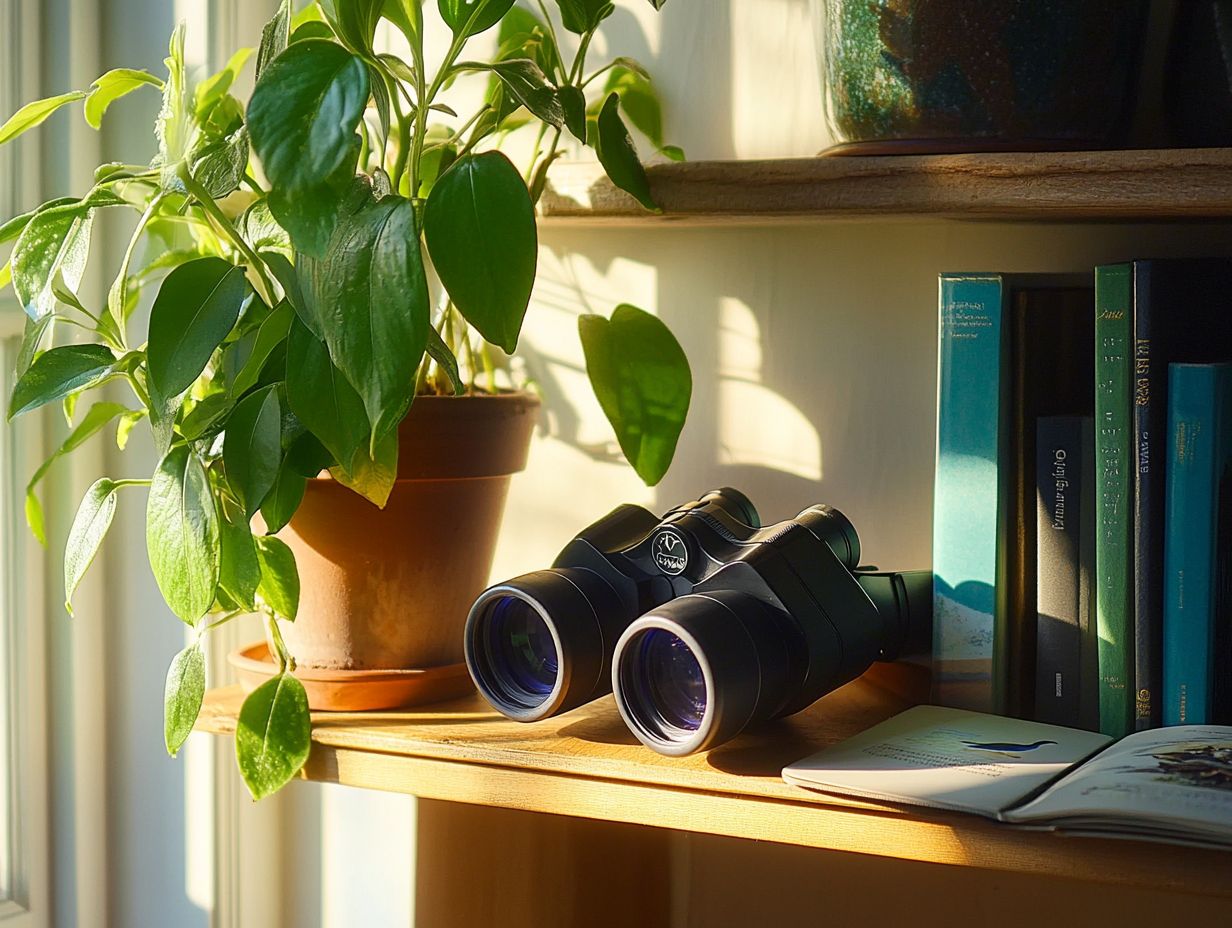
Selecting the perfect storage spot for your binoculars is crucial. It helps prevent damage and keeps them clean for your next birdwatching adventure.
Aim for a location that is dry, cool, and shielded from sunlight. This protects the optics and lens coatings. A protective binocular case adds extra security, especially for waterproof models designed for tough conditions.
Choosing the right storage space maintains cleanliness and enhances longevity. Enjoy crisp, high-quality images for years to come!
Factors to Consider
When choosing a storage location, consider several important factors. This maximizes your binoculars’ performance and usability, especially if you wear eyeglasses.
Temperature plays a significant role. Extreme heat or cold can affect the lubricant, the substance that helps the focusing knob move smoothly, making adjustments feel rough.
Humidity is also critical. Too much moisture can lead to internal fogging or mold, which compromises the quality of your optics.
Accessibility matters too. Storing your binoculars in a secure yet reachable spot ensures they re always ready for spontaneous adventures.
Don’t overlook lens coatings. They enhance light transmission and reduce glare, enriching your viewing experience.
Storage Containers for Binoculars
Storage containers for binoculars come in various types. Each offers distinct advantages for your birdwatching and outdoor adventures.
Selecting the right container shields your binoculars from physical damage. It also protects them from environmental factors that could compromise optical performance.
Binocular harnesses offer convenience and accessibility, keeping your gear close at hand. Lens covers act as vital barriers against dirt and scratches.
Explore the array of containers available, many of which you can find in camera stores. Ensure your binoculars stay in peak condition for every birdwatching excursion.
Types of Containers and Their Benefits
Various containers are designed specifically for binoculars. Each offers distinct advantages for safeguarding and maintaining your birding equipment.
Soft cases provide a lightweight and flexible solution. They are easy to carry on long hikes while cushioning your binoculars against bumps.
Hard cases deliver robust protection against drops and rough handling. They are perfect for those venturing into rugged environments with their gear.
Waterproof options are beneficial for birdwatchers facing unpredictable weather. They shield the optics from moisture and dust.
Tips for Long-Term Storage
To keep your binoculars in pristine condition, follow these essential tips for long-term storage. Proper care ensures they remain ready for your birdwatching adventures!
How to Protect Binoculars from Damage
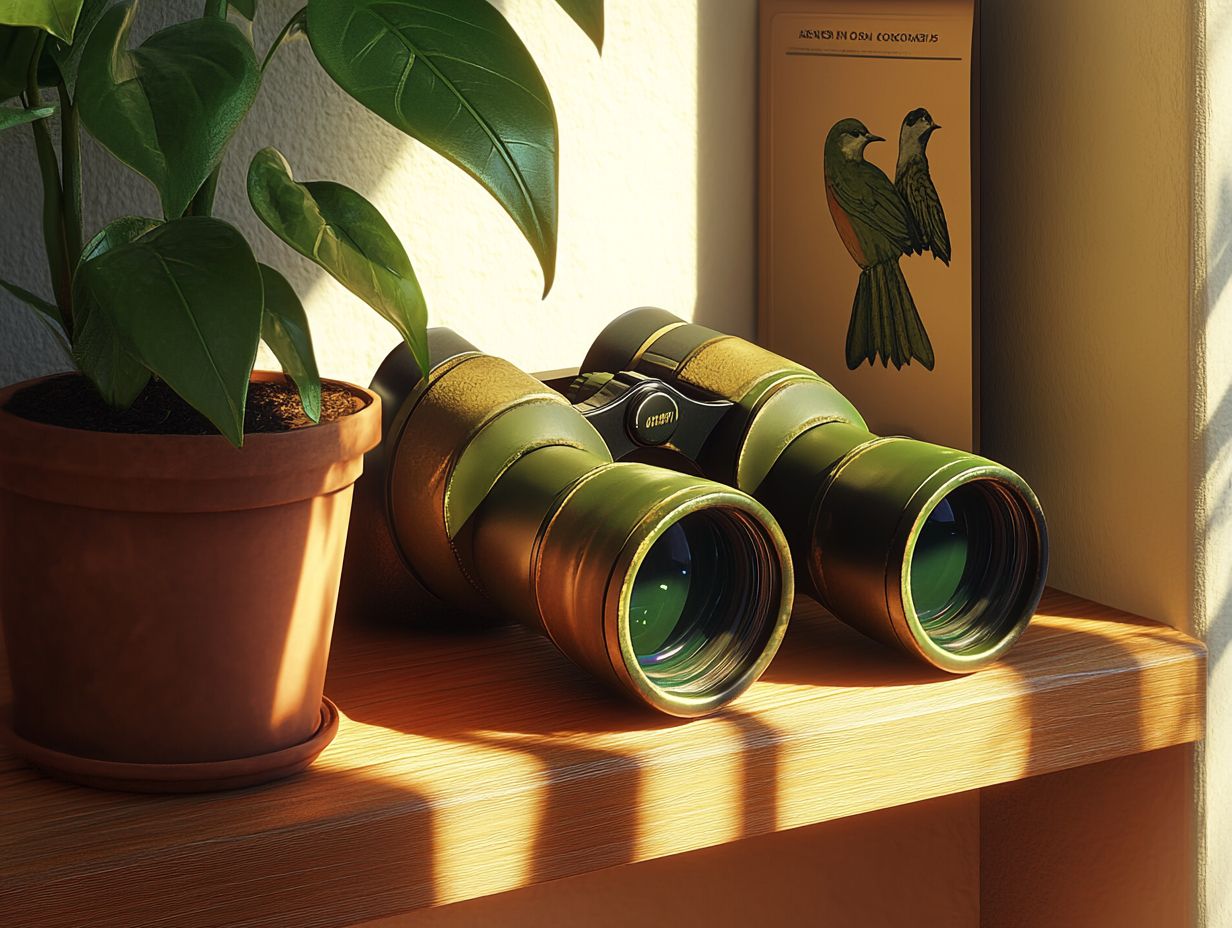
Want to keep your binoculars safe? Use these simple cleaning and handling tips to ensure their durability and performance.
When enjoying activities like birdwatching or stargazing, it’s crucial to preserve their functionality over time. Investing in high-quality optics will greatly enhance your visual experience, making it essential to choose premium equipment.
Regular maintenance, such as monitoring for moisture and dirt build-up, can prevent long-term damage. Consider using a protective case to shield your binoculars from harsh environmental elements.
Handling them with clean hands and using secure straps when they’re not in use can significantly minimize the risk of accidental drops and scratches, ensuring you enjoy a seamless experience for many years.
Retrieving and Using Stored Binoculars
Retrieving and using stored binoculars requires careful attention to detail, ensuring they re ready for immediate use when that perfect birdwatching moment arises. Before taking them out, check the binoculars for any dust or dirt that might have settled during storage.
Using the right cleaning techniques will keep the lenses clear and fully functional. Understanding the right storage conditions is essential to protect your birding equipment, allowing you to immerse yourself in the joy of bird observation without distractions.
Proper Techniques for Bringing Out Stored Binoculars
Bringing out your stored binoculars requires a careful approach to ensure they are handled with care and remain in pristine condition.
- Start by gently removing the eyepiece cover by twisting it off counterclockwise, being careful not to apply excessive force that could cause damage.
- Once the cover is off, use a soft lens cloth to wipe down the glass surfaces. This will help eliminate any dust and smudges without risking scratches.
- After cleaning the lenses, take a moment to adjust the focus knob carefully; improper adjustments can ruin your viewing experience.
A light touch is essential, as aggressive twisting might misalign the optics, compromising performance over time.
Frequently Asked Questions
What are some tips for storing my birdwatching binoculars?
- Always store your binoculars in a dry and cool place. Avoid humid environments, as moisture can damage the lenses.
- Use a protective case or pouch to prevent scratches and dings. This will also keep your binoculars safe from dust and dirt.
- Avoid direct sunlight when storing your binoculars. Prolonged exposure to UV rays can damage the lenses and affect image quality.
- Don’t store your binoculars near chemicals or strong odors, as these can damage the materials.
- Always clean and dry your binoculars before storing them to prevent dirt from accumulating on the lenses.
- If you have adjustable eyecups, store them in the down position to avoid potential damage.
How should I clean my binoculars before storing them?
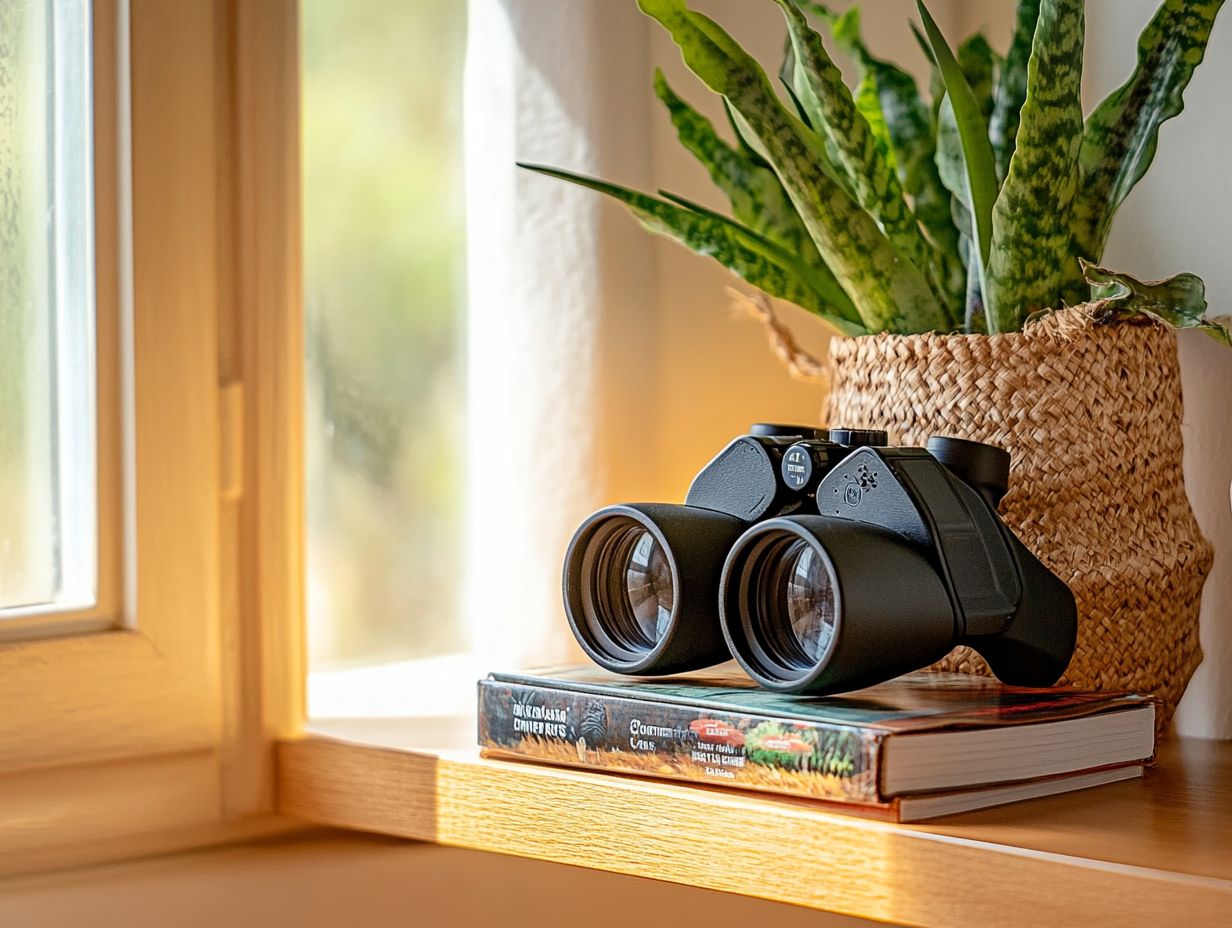
- Use a soft, lint-free cloth to gently wipe the lenses and body of the binoculars.
- If there are stubborn spots or smudges, use a lens cleaning solution designed for binoculars or a mild soap solution (a few drops of dish soap mixed with water).
- Avoid harsh chemicals or abrasive materials, as these can harm the lenses.
- Dry the binoculars thoroughly with a soft cloth before storing them.
Should I remove the batteries from my binoculars before storing them?
If your binoculars have a built-in battery, it’s recommended to remove it before storing. This prevents any potential battery leakage that can damage the internal parts.
By following these tips, you can keep your binoculars in top shape and ready for your next adventure!
Is it okay to store my binoculars with the lens caps on?
Yes, storing your binoculars with the lens caps on is a great idea. This protects the lenses from dust and debris.
Can I hang my binoculars when storing them?
No, hanging your binoculars is not a good practice. It can strain the neck strap and may lead to accidental falls.
How often should I clean and maintain my binoculars?
Clean your binoculars after each use to keep them in top condition. This ensures they are always ready for your next bird-watching adventure!

